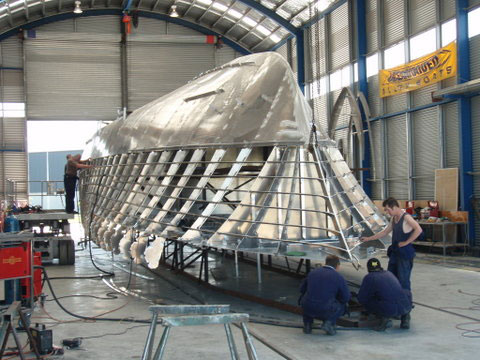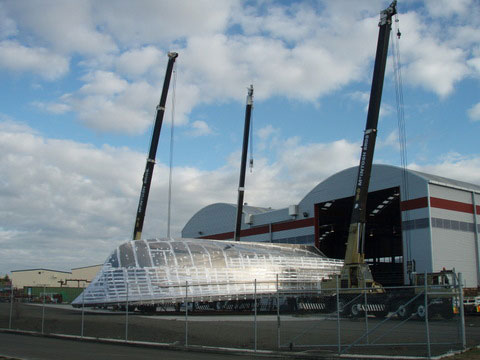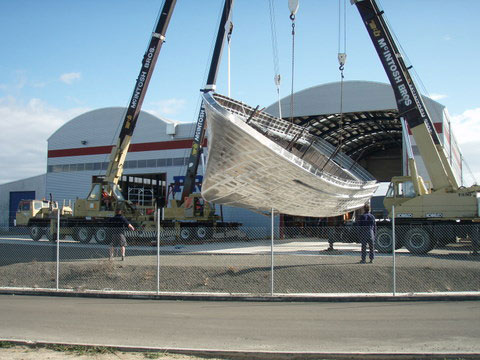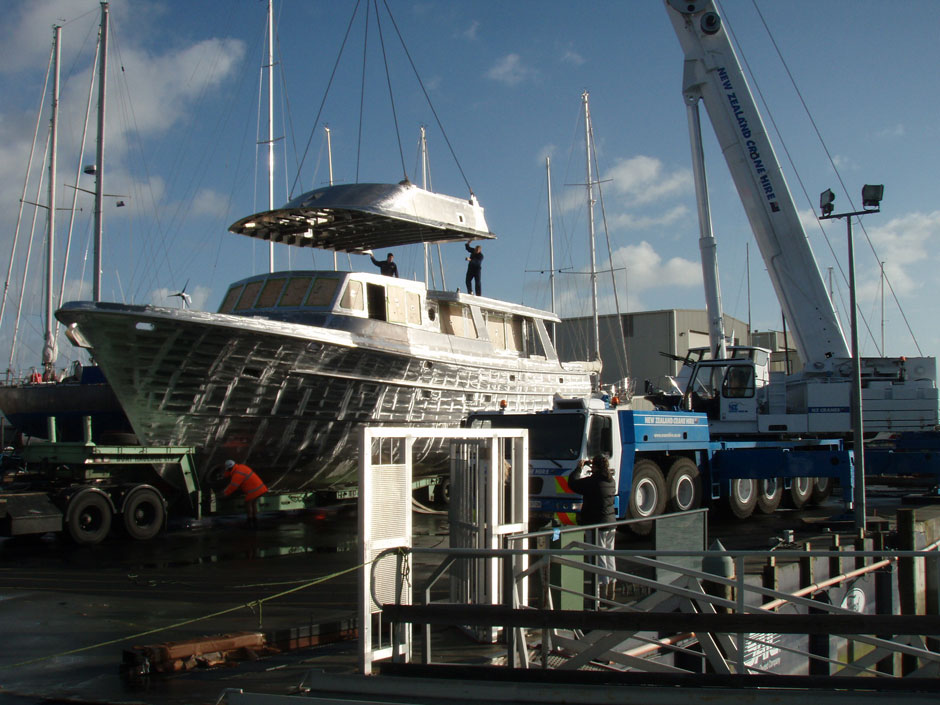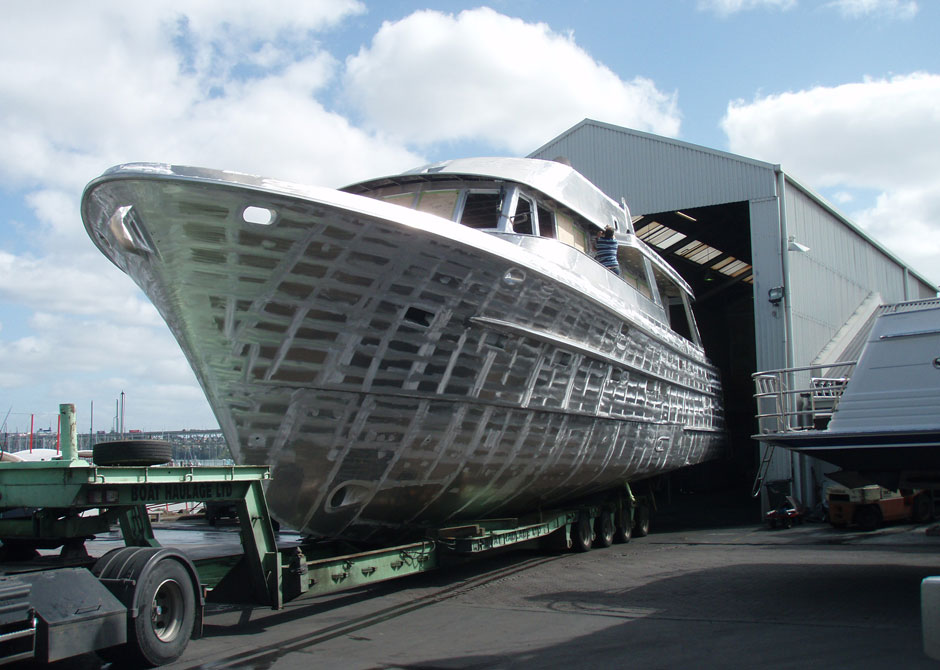
SAFETY COMFORT AND SPEED
The design brief for Adagio had three distinct primary themes: vessel safety, comfort at sea, and fuel-efficient speed made while ocean cruising. Yacht architecture solves problems with detailed connections between all of these subjects. There are details that can be pointed out that make Adagio a superior vessel and very well found for its intended purpose: long range ocean cruising.
The subject of safety was evaluated knowing the cruising plan had several long offshore passages with little or no chance of rescue. Passages made across the Tasman Sea from New Zealand or New Zealand to Fiji requires self sufficiency for long periods of time in potentially adverse conditions. Mechanical systems must be reliable and the structural engineering able to withstand forces well beyond “recreational grade.”
The hull and deck structure of Adagio was designed to meet the scantling rules for offshore motor yachts written by the American Bureau of Shipping. These scantling rules provide high safety factors and methods of assembly that reduce the possibility of structural failure under the most adverse conditions. We added to that several of our own philosophies of construction to even make the yacht exceed the construction code of ABS:
- The use of high strength Alustar/Sealium aluminum alloy:
This material is 20% stronger than the standard 5083 alloy. However, the most advantages aspect of Alustar is the resistance to corrosion, particularly in the weld areas. This gives security even over time in areas of the internal structure that are inaccessible and often prone to corrosion.
- Full length bilge margin plates and integral tanks:
Forward of the main bulkhead amidships, the bilge has a heavy 8 mm margin plate that creates the tanks sides. Once plated over side to side this plate and the tanks create a double bottom. In the forward crash area another raised watertight compartment was included. This provided a double hull bottom in the area where submerged objects would make contact with the stem. The bow thruster is also enclosed within this space should any leaking ever occur through its motor shaft.
- High grade/high quality materials in mechanical systems: With propeller shafts of Aquamet 22 stainless steel, copper nickel sea water piping, and high pressure fuel piping the longevity and reliability is increased. The boat was designed with highest reliability and least risk over any sort of economy, value engineering, or cost savings.
The subject of safety was also addressed in the yacht’s ergonomics and comfort. A vessel at sea that keeps crew secure and well rested is far safer than a fatigued and stressed crew. The vessel must provide security to move about both interior and exterior. Adagio’s Portuguese bridge, deep bulwarks, and full one meter railings allow safe movement on deck even in large ocean swells. The interior spaces were laid out to provide security within them. The galley being a good example: it is located central in the vessel and at the centre of rotation. Staterooms are well insulated, well ventilated, environmentally controlled with air-con/heat, and have proper lighting. Adagio was designed to be an honest ocean going vessel, unlike many of the available production counterparts whose life is spent largely on mooring or in the slip.
Comfort is a complicated matrix combining the right amount of interior space supported by a hull shape that has good motion and least resistance under power. Adagio’s hull shape is described in detail here under DESIGN – Hull Design. This hull shape is an evolution that has occurred over 32 years of my career and is based in the work of the late Jack Hargrave. Adagio’s hull design is the benefit of this experience, research, and development.
Steering and control are the second most important aspects of a hull design. We fulfilled the low resistance high stability requirement with the transitional chine hull shape and fine forward sections. The ability to steer and stay in control in large ocean swells is a function of the rounded forward sections, built down keel, and NACA foil shaped rudders. Built down keels are almost unknown today in modern poweryacht design. The keel sides and hull bottom surface come together in a large gentle radius. Thus, the keel is not causing the hull to bow steer or create high directional pressures that the rudders cannot overcome. The large foil shaped rudders provide good control even at idle speeds. This combined with a powerful bow and stern thruster system makes mooring the vessel easy and worry free. The other benefits to built-down keels is a lower center of gravity and they are immensely strong should grounding occur.
Blues legend Taj Mahal coined the phrase, “built for comfort not for speed,” in his song of the same name. It is a simile that applies to power yachts at sea. Unless a hull is of the wave piercing type or in excess of 60 meters long, speeds above 12 knots are not practical or even achievable offshore. Adagio’s refined hull allows her to cruise 1.3 knots above theoretical hull speed. While this may seem trivial at first inspection, it is a 10 percent increase, and the hull achieves this at any loading. Study similar passagemakers and you will find many cannot even make hull speed. This is typical among the deep fishing boat-type hulls that are ballasted. Moreover, Adagio can maintain a 10-12 knots cruising speed, even in fairly heavy going with a comfortable motion. It is reported by the crew that Adagio has not buried her bow even in four meter seas. A hull speed of 10-12 knots is perfect for long ocean crossings. The fuel efficiency is good, noise is low, and the motion is comfortable.
Adagio has met or exceeded her design expectations in all respects. When there is 200 meters of water below you and landfall is 1000 kilometers away there is no compromise. The owner’s brief for the project started with a no compromise philosophy and the yacht lives up to it. Under Adagio’s tough shell is a graceful yacht that supports and allows a state of ease and well being at sea.
Mark Fitzgerald, Chuck Payne Yacht Design
(now of Fitzgerald Marine Architecture)

